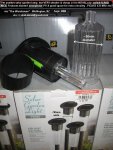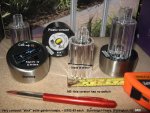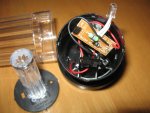Yes-sorry- solar garden lamps are now so tedious a technology that the mere mention of them can bring on disdain. Hardware shops globally are stuffed with them, & it seems every season a variation on their theme arises, only to end up the bargain bins.
However I've just noted a "4 for US$10" offering here in NZ that could suit elevated PICAXE projects. For starters it's PV is slanted,which sheds rain & bird droppings,& also better matches non tropical solar angles. The AAA NiCd & (switched) electronics are normal,but space exists beside then for extra compact circuitry. The ~50mmm diameter suits easy elevation on a suitable plastic pipe, bamboo etc. Perhaps best of all, once aloft the unit would be almost unobtrusive.
Request- to suit a possible "Si Chip" application with a solar powered HopeRF 433MHz mesh data network. Can any Australian Forum readers please cast their eye over local hardware outlet garden lamp offerings, & mention if this style is now available in Oz. TIA- Stan.
However I've just noted a "4 for US$10" offering here in NZ that could suit elevated PICAXE projects. For starters it's PV is slanted,which sheds rain & bird droppings,& also better matches non tropical solar angles. The AAA NiCd & (switched) electronics are normal,but space exists beside then for extra compact circuitry. The ~50mmm diameter suits easy elevation on a suitable plastic pipe, bamboo etc. Perhaps best of all, once aloft the unit would be almost unobtrusive.
Request- to suit a possible "Si Chip" application with a solar powered HopeRF 433MHz mesh data network. Can any Australian Forum readers please cast their eye over local hardware outlet garden lamp offerings, & mention if this style is now available in Oz. TIA- Stan.
Attachments
-
95.1 KB Views: 321





